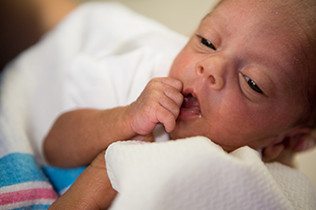Definisi
Ensefalokel adalah kelainan penutupan tabung saraf yang memengaruhi otak. Ensefalokel dapat tampak saat lahir, terlihat seperti kantong yang tersambung ke kepala dan berisi otak serta selaputnya. Ensefalokel terjadi pada 1 dari 10.000 kelahiran hidup. Angka kejadiannya lebih tinggi pada negara berkembang daripada negara maju.
Penyebab
Tabung saraf merupakan sebuah kanal sempit yang melipat dan menutup pada minggu ketiga hingga keempat kehamilan untuk membentuk otak dan sumsum tulang belakang. Jika penutupan tabung saraf terganggu akibat berbagai faktor, berbagai kelainan dapat terjadi. Kelainan ini dapat berupa ensefalokel, meningokel (kantong di luar kepala berisi selaput otak), spina bifida (gangguan penutupan tabung saraf pada bagian sumsum tulang belakang), dan anensefali (kegagalan pembentukan otak besar, otak kecil, dan tulang tengkorak). Gangguan penutupan tabung saraf ini dapat disebabkan oleh faktor genetik dan lingkungan. Faktor genetik dapat diperparah oleh pernikahan sedarah dan riwayat kehamilan dengan gangguan penutupan tabung saraf sebelumnya. Faktor lingkungan dapat berupa infeksi dalam kehamilan, misalnya infeksi TORCH (toksoplasma, rubella, cytomegalovirus, herpes simpleks). Terdapat lebih dari 30 sindroma (kumpulan tanda dan gejala yang dapat berkaitan satu sama lain sebagai bagian dari suatu kelainan atau penyakit) yang terkait dengan ensefalokel.
Gangguan penutupan tabung saraf yang mengakibatkan ensefalokel dapat terjadi pada bagian depan dan belakang kepala. Berdasarkan letak ensefalokel, kelainan penyerta dapat terjadi di otak dan jaringan sekitarnya.
Faktor Risiko
Ensefalokel lebih mudah terjadi pada keluarga dengan riwayat gangguan penutupan tabung saraf lainnya seperti spina bifida dan anensefali. Adanya infeksi pada masa kehamilan juga meningkatkan risiko ini, terutama pada infeksi TORCH. Penderita ensefalokel berisiko untuk mengalami kematian apabila lahir prematur, memiliki berat badan lahir rendah, serta memiliki kelainan pada bagian tubuh lainnya.
Gejala
Ensefalokel dapat dikenali sebagai massa atau benjolan pada kepala bagian depan atau belakang yang tertutup kulit. Berdasarkan lokasi terjadinya, ensefalokel dibagi menjadi dua, yaitu ensefalokel anterior (depan) dan ensefalokel posterior (belakang).
Ensefalokel anterior dapat melibatkan jembatan hidung, bagian tengah alis, serta sebelah tengah mata. Jika melibatkan area di dalam hidung, ensefalokel ini dapat menyebabkan beberapa gejala, seperti:
- hidung tersumbat
- mendengkur
- kebocoran cairan dekat otak (disebut juga dengan cairan serebrospinal, yang bening dan tekstur cair)
- keluar cairan bening dari hidung (yang sebenarnya merupakan cairan serebrospinal yang bocor)
Ensefalokel posteror (belakang) biasanya terjadi di atas tengkuk. Pada ensefalokel jenis ini, dapat terjadi beberapa gejala, seperti:
- adanya kelainan bentuk wajah serta jarak antara kedua mata terlalu jauh (hipertelorisme)
- kejang
- keluarnya cairan bening dari hidung atau telinga
Diagnosis
Diagnosis untuk menegakkan ensefalokel dapat dimulai dari pemeriksaan langsung. Massa yang menonjol dari kepala, jika disinari, dapat terlihat bercahaya. Hal ini terjadi apabila kantong tersebut berisi banyak cairan seperti cairan serebrospinal. Selanjutnya, pemeriksaan pencitraan dapat dilakukan, seperti magnetic resonance imaging (MRI) untuk melihat jaringan di dalam kantong yang keluar dari kepala, atau computed tomography (CT) scan untuk melihat bagian tulang tengkorak yang hilang serta adanya cairan dalam otak yang berlebihan (hidrosefalus). Apabila isi otak masuk ke dalam hidung, pemeriksaan langsung dapat menunjukkan hasil mirip polip hidung. Namun, polip hidung sangat jarang terjadi pada bayi, sehingga adanya massa di dalam hidung pada bayi dapat meningkatkan kecurigaan terhadap ensefalokel.
Diagnosis ensefalokel dapat dilakukan pula pada saat kehamilan. Pemeriksaan yang biasanya dipilih adalah ultrasonografi (USG), yang dilakukan antara minggu ke-9 sampai minggu ke-11 kehamilan. Pada pemeriksaan USG, dapat tampak kantong berisi cairan yang menembus tulang tengkorak. Jika pemeriksaan ini diulang pada minggu ke-13 kehamilan, kantong ini dapat diisi oleh selaput otak saja (meningokel) atau dengan isi otak juga (ensefalokel). Selain itu, pemeriksaan lainnya yang dapat dilakukan adalah pemeriksaan genetik untuk mengetahui adanya kelainan materi genetik.
Jika hasil pemeriksaan USG menunjukkan adanya kemungkinan ensefalokel, pemeriksaan organ-organ lainnya dapat pula dilakukan untuk mengetahui kemungkinan sindroma yang dimiliki janin.
Tata Laksana
Tata laksana ensefalokel adalah pembedahan. Tujuan pembedahan adalah menutup lubang pada tulang tengkorak dan lapisan di bawahnya, memotong jaringan kulit yang berlebihan, serta membuang jaringan otak yang tidak berfungsi. Jika pembedahan dilakukan pada bayi atau anak dengan ensefalokel anterior, tulang-tulang wajah akan terbentuk sendiri nantinya. Namun, apabila jarak antara kedua mata terlalu jauh, pembedahan dapat dilakukan untuk memperbaiki bentuk wajah dan posisi kedua mata. Pembedahan biasanya dilakukan secara terbuka, namun dapat dilakukan dengan alat endoskopi apabila melibatkan daerah dekat hidung.
Pembedahan dilakukan tergantung ukuran, lokasi, komplikasi terkait, serta keberadaan kulit yang melapisi ensefalokel. Apabila ada lapisan kulit yang bersifat sebagai pelindung, pembedahan dapat ditunda hingga beberapa bulan atau tahun. Biasanya, pembedahan akan dilakukan pada usia 2-3 tahun. Sementara itu, apabila tidak ada lapisan kulit yang melindungi ensefalokel, pembedahan sebaiknya dilakukan segera setelah lahir. Jika ensefalokel terjadi di bagian dasar kepala, pembedahan lebih baik jika cepat dilakukan untuk mencegah infeksi dan isi otak masuk ke hidung.
Penutupan tulang tengkorak dilakukan dengan transplantasi tulang sendiri (autolog), titanium, dan bahan lainnya. Namun, jika lubang tengkorak kecil, kemungkinan penutupan tidak perlu dilakukan.
Komplikasi
Komplikasi tersering ensefalokel adalah kebocoran cairan serebrospinal dari hidung dan/atau telinga serta meningitis. Meningitis atau infeksi selaput otak dapat ditandai dengan demam, nyeri kepala, kejang, dan penurunan kesadaran. Selain itu, komplikasi ensefalokel lainnya adalah kejang, adanya cairan serebrospinal yang berlebihan di dalam kepala (hidrosefalus), serta gangguan atau keterlambatan pertumbuhan dan perkembangan.
Pencegahan
Ensefalokel kemungkinan tidak dapat dicegah, namun ada beberapa kondisi terkait yang dapat dihindari, seperti infeksi pada kehamilan. Langkah-langkah berikut dapat dilakukan untuk mencegah infeksi pada kehamilan:
- Melindungi diri sendiri dari infeksi Zika. Jika Anda sedang hamil, hindari bepergian ke daerah dengan angka kejadian infeksi Zika tinggi.
- Rajin mencuci tangan, terutama setelah menggunakan kamar mandi, menyentuh daging, telur, atau sayuran mentah, menyiapkan makan dan makan, menyentuh tanah, bermain dengan hewan peliharaan, berkontak dengan orang sakit, terkena ludah, bermain atau mengurus anak kecil, serta mengganti popok anak.
- Kurangi kontak dengan ludah dan kencing bayi atau anak kecil, karena dapat mengandung cytomegalovirus (CMV), yang dapat menyebabkan pertumbuhan otak yang terhambat serta tuli pada janin. Hal ini dapat dilakukan dengan tidak berbagi makanan dan alat makan dengan bayi dan anak kecil, serta mencuci tangan setelah mengganti popok.
- Hindari produk susu yang tidak dipasteurisasi. Produk susu yang tidak dipasteurisasi dapat mengandung bakteri yang berbahaya bagi janin.
- Jangan menyentuh atau membersihkan kotoran kucing, karena kotoran kucing dapat mengandung toksoplasma, parasit yang dapat menyerang janin. Jika Anda harus membersihkan kotoran tersebut sendiri, gunakan sarung tangan dan cucilah tangan setelahnya.
- Jauhi hewan pengerat, baik peliharaan maupun liar, seperti tikus, hamster, guinea pig (tikus belanda) karena dapat membawa virus koriomeningitis limfositik (lymphocyitic choriomeningitis virus, LCMV).
- Kunjungi fasilitas kesehatan terdekat untuk pemeriksaan penyakit menular seksual seperti HIV, hepatitis B, sifilis, gonorea, dan sebagainya. Penyakit-penyakit ini kadang tidak menimbulkan gejala, sehingga keberadaannya seringkali tidak diketahui. Pemeriksaan awal sebelum kehamilan sangat baik untuk memastikan kehamilan aman.
- Kunjungi fasilitas kesehatan terdekat untuk vaksinasi, misalnya seperti vaksinasi tetanus yang penting dipenuhi sebelum hamil dan melahirkan.
- Hindari orang yang sedang terinfeksi, apapun bentuk infeksinya. Rubella, misalnya, dapat mengakibatkan demam yang bisa disertai ruam, namun tidak selalu. Namun, virus ini sangat berbahaya bagi janin karena dapat menyebabkan kelainan bawaan.
Kapan Harus ke Dokter?
Segeralah ke dokter apabila anak Anda memiliki massa yang muncul dari kepala sejak lahir. Massa ini bisa merupakan ensefalokel, namun bisa juga disebabkan oleh penyebab lainnya. Tata laksana mungkin dapat dilakukan segera atau menunggu beberapa waktu, dan hal ini sebaiknya dikonsultasikan kepada dokter. Ensefalokel, jika tidak ditangani, dapat berakibat mulai dari gangguan penampilan hingga infeksi selaput otak (meningitis) yang dapat mengancam nyawa.
Mau tahu informasi seputar penyakit pada saraf lainnya? Yuk, baca lebih banyak artikelnya di sini!
- dr Ayu Munawaroh, MKK
Cruz, A., & Jesus, O. (2021). Encephalocele. Retrieved 20 December 2021, from https://www.ncbi.nlm.nih.gov/books/NBK562168/
Facts about Encephalocele | CDC. (2020). Retrieved 20 December 2021, from https://www.cdc.gov/ncbddd/birthdefects/encephalocele.html
Khan, A. (2020). Encephalocele Imaging: Practice Essentials, Radiography, Computed Tomography. Retrieved 20 December 2021, from https://emedicine.medscape.com/article/403308-overview#a1
Preventing Infections in Pregnancy | CDC. (2021). Retrieved 20 December 2021, from https://www.cdc.gov/pregnancy/infections.html












